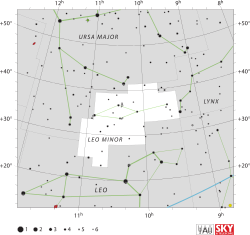HD 87822
| HD 87822 | |
 | |
| Observationsdata Epok: J2000.0 | |
|---|---|
| Stjärnbild | Lilla lejonet |
| Rektascension | 10t 08m 15,88717s[1] |
| Deklination | +31° 36′ 14,5875″[1] |
| Skenbar magnitud () | +6,240 (V)[2] (6,90 + 7,20) [3] |
| Stjärntyp | |
| Spektraltyp | F4 V[4] |
| U–B | +0,01[5] |
| B–V | +0,445[5] |
| Astrometri | |
| Radialhastighet () | -8,0[2] km/s |
| Egenrörelse (µ) | RA: -80,47[1] mas/år Dek.: -92,07[1] mas/år |
| Parallax () | 16,33 ± 0,42[1] |
| Avstånd | 200 ± 5 lå (61 ± 2 pc) |
| Absolut magnitud () | 2,23[2] |
| Detaljer | |
| Radie | 2,60[6] R☉ |
| Luminositet | 10,28[6] L☉ |
| Temperatur | 6 533[4] K |
| Metallicitet | 0,10 (Fe/H) [4] dex |
| Vinkelhastighet | 8[7] km/s |
| Ålder | 1,6[2] miljarder år |
| Andra beteckningar | |
| CCDM J10083+3136AB, AG+31 989, BD+32 1982, GSC 02503-00253, HD 87822, HIC 49658, HIP 49658, HR 3979, IRAS 10053+3151, 2MASS J10081588+3136147, PPM 75010, 1RXS J100817.9+313617, SAO 61882, TD1 14577, TYC 2503-253-1, uvby98 100087822, WDS J10083+3136AB, Gaia DR2 745776957342208512 [8] | |
HD 87822 är en dubbelstjärna belägen i den mellersta delen av stjärnbilden Lilla lejonet. Den har en kombinerad skenbar magnitud av ca 6,24[2] och är mycket svagt synlig för blotta ögat där ljusföroreningar ej förekommer. Baserat på parallaxmätning inom Hipparcosuppdraget på ca 16,3[1] mas, beräknas den befinna sig på ett avstånd på ca 200 ljusår (ca 61 parsek) från solen. Den rör sig närmare solen med en heliocentrisk radialhastighet på ca -8 km/s.[2]
Egenskaper
[redigera | redigera wikitext]Primärstjärnan HD 87822 A är en gul till vit stjärna i huvudserien av spektralklass F4 V.[4] Den har en radie som är ca 2,6[6] solradier och har ca 10 gånger solens utstrålning av energi[6] från dess fotosfär vid en effektiv temperatur av ca 6 500 K.[4]
HD 87822 är en dubbelstjärna med en omloppsperiod av ca 17,7 år i en bana med en excentricitet av 0,3960.[9]
Referenser
[redigera | redigera wikitext]- Den här artikeln är helt eller delvis baserad på material från engelskspråkiga Wikipedia, HD 87822, 13 september 2020.
Noter
[redigera | redigera wikitext]- ^ [a b c d e f] van Leeuwen, F. (2007), "Validation of the new Hipparcos reduction", Astronomy and Astrophysics, 474 (2): 653–664, arXiv:0708.1752, Bibcode:2007A&A...474..653V, doi:10.1051/0004-6361:20078357
- ^ [a b c d e f] Holmberg, J.; et al. (2007), "The Geneva-Copenhagen survey of the Solar neighbourhood. II. New uvby calibrations and rediscussion of stellar ages, the G dwarf problem, age-metallicity diagram, and heating mechanisms of the disk", Astronomy & Astrophysics, 475 (2): 519–537, arXiv:0707.1891, Bibcode:2007A&A...475..519H, doi:10.1051/0004-6361:20077221
- ^ Malkov, O. Yu.; et al. (2012), "Dynamical Masses of a Selected Sample of Orbital Binaries", Astronomy & Astrophysics, 546: 5, Bibcode:2012A&A...546A..69M, doi:10.1051/0004-6361/201219774, A69
- ^ [a b c d e] Cenarro, A. J.; et al. (January 2007), "Medium-resolution Isaac Newton Telescope library of empirical spectra - II. The stellar atmospheric parameters", Monthly Notices of the Royal Astronomical Society, 374 (2): 664–690, arXiv:astro-ph/0611618, Bibcode:2007MNRAS.374..664C, doi:10.1111/j.1365-2966.2006.11196.x
- ^ [a b] Mermilliod, J.-C. (1986), "Compilation of Eggen's UBV data, transformed to UBV (unpublished)", Catalogue of Eggen's UBV Data. SIMBAD, Bibcode:1986EgUBV........0M
- ^ [a b c d] https://www.universeguide.com/star/49658/hd87822. Hämtad 2020-09-13
- ^ Uesugi, Akira; Fukuda, Ichiro (1970). "Catalogue of rotational velocities of the stars". Contributions from the Institute of Astrophysics and Kwasan Observatory. University of Kyoto. Bibcode:1970crvs.book.....U.
- ^ http://simbad.u-strasbg.fr/simbad/sim-id?Ident=HD+87822. Hämtad 2020-09-13.
- ^ Hartkopf, William I.; Mason, Brian D.; McAlister, Harold A. (1996). "Binary Star Orbits From Speckle Interferometry. VIII. Orbits of 37 Close Visual System". Astronomical Journal. 111: 370. Bibcode:1996AJ....111..370H. doi:10.1086/117790.




